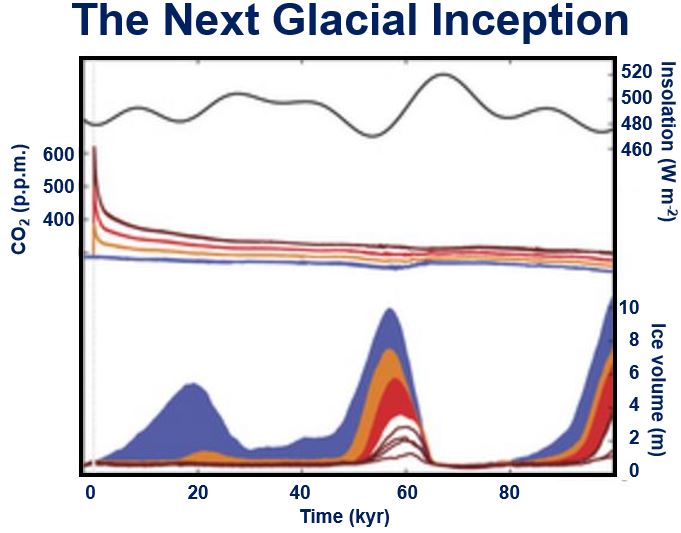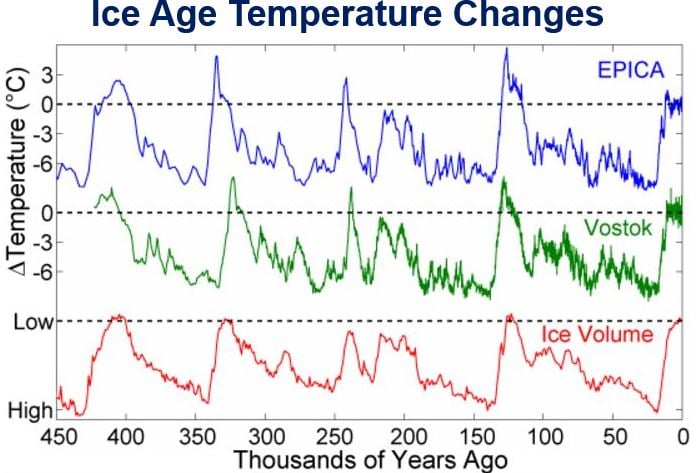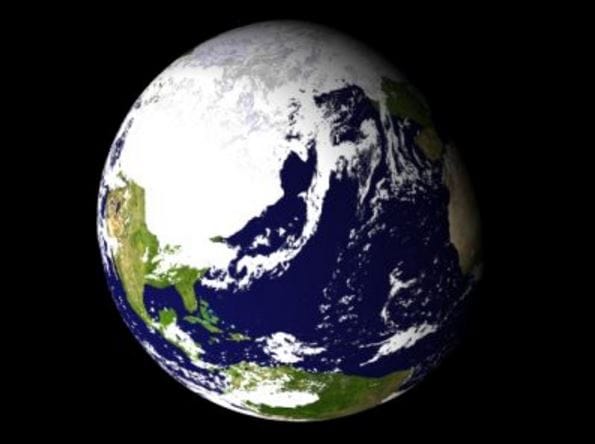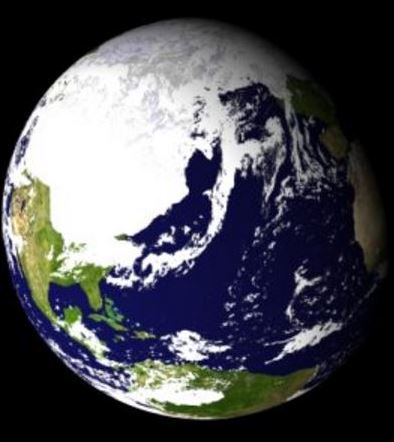The next Ice Age will come later because of climate change caused by human activity. Global warming, caused mainly by our burning of fossil fuels, will probably put back the next glacial inception (Ice Age start) by about 100,000 years, says a new study led by scientists at the Potsdam Institute for Climate Impact Research in Germany.
The team of German and American researchers, who wrote about their study and findings in the academic journal Nature, explain that humans have become a geological force that is able to suppress the onset of the next Ice Age.
The authors, who say they cracked the code of glacial inception, found the relation of insolation and carbon dioxide (CO2) concentrations in the atmosphere to be the main criterion to explain Earth’s last eight ice ages.
 According to this simulation, the next Ice Age will arrive in about 100,000 years’ time (with no human interference). (Image: nature.com)
According to this simulation, the next Ice Age will arrive in about 100,000 years’ time (with no human interference). (Image: nature.com)
Their results also illustrate that even moderate interference by humans with Earth’s natural carbon balance could postpone the next glacial inception by approximately 100,000 years.
Next Ice Age at least 50,000 years away
Lead author, Dr. Andrey Ganopolski, said:
“Even without man-made climate change we would expect the beginning of a new ice age no earlier than in 50.000 years from now – which makes the Holocene as the present geological epoch an unusually long period in between ice ages.”
“However, our study also shows that relatively moderate additional anthropogenic CO2-emissions from burning oil, coal and gas are already sufficient to postpone the next ice age for another 50.000 years. The bottom line is that we are basically skipping a whole glacial cycle, which is unprecedented. It is mind-boggling that humankind is able to interfere with a mechanism that shaped the world as we know it.”
The authors say that for the first time, they can explain the onset of the last eight ice ages by quantifying a number of key factor that preceded the formation of each glacial cycle.
Dr. Ganopolski said:
“Our results indicate a unique functional relationship between summer insolation and atmospheric CO2 for the beginning of a large-scale ice-sheet growth which does not only explain the past, but also enables us to anticipate future periods when glacial inception might occur again.”
 During ice ages temperatures drop and ice volumes increase. Just before each one begins there are periods of very low solar radiation in the summer. (Image: en.wikipedia.org)
During ice ages temperatures drop and ice volumes increase. Just before each one begins there are periods of very low solar radiation in the summer. (Image: en.wikipedia.org)
Humankind as a geological force
Using a sophisticated Earth system model simulating ocean, atmosphere, ice-sheet and global carbon cycle simultaneously, the researchers analyzed the effected of further CO2 emissions caused by human activity on the ice volume on the Northern Hemisphere.
Co-author Dr. Ricarda Winkelmann, Junior Professor of Climate System Analysis at the Physics Institute of Potsdam University and Potsdam Institute for Climate Impact Research, said:
“Due to the extremely long life-time of anthropogenic CO2 in the atmosphere, past and future emissions have a significant impact on the timing of the next glacial inception.”
“Our analysis shows that even small additional carbon emissions will most likely affect the evolution of the Northern Hemisphere ice sheets over tens of thousands of years, and moderate future anthropogenic CO2-emissions of 1000 to 1500 Gigatons of Carbon are bound to postpone the next ice age by at least 100.000 years.”
 During an Ice Age, the temperature is very cold and glaciers cover large parts of the Earth. (Image: theresilientearth.com)
During an Ice Age, the temperature is very cold and glaciers cover large parts of the Earth. (Image: theresilientearth.com)
The quest for the causes of glacial cycles remains one of the key questions of Earth system analysis and especially paleoclimatology, the study of climate changes spanning the entire history of our planet.
Generally, the onset of a new ice age is market by periods of extremely low solar radiation in the summer – this is currently happening. However, there is no evidence suggesting we are at the beginning of a new ice age.
Ice ages shape global environment
Dr. Winkelmann said:
“This is the motivation for our study. Unravelling the mystery of the mechanisms driving past glacial cycles also facilitates our ability to predict the next glacial inception.”
Co-author, Professor Hans Joachim Schellnhuber, founding Director of the Potsdam Institute for Climate Impact Research and Chair of the German Advisory Council on Global Change, said:
“Like no other force on the planet, ice ages have shaped the global environment and thereby determined the development of human civilization. For instance, we owe our fertile soil to the last ice age that also carved out today’s landscapes, leaving glaciers and rivers behind, forming fjords, moraines and lakes.”
“However, today it is humankind with its emissions from burning fossil fuels that determines the future development of the planet. This illustrates very clearly that we have long entered a new era, and that in the Anthropocene humanity itself has become a geological force. In fact, an epoch could be ushered in which might be dubbed the Deglacial.”
The next ice age is a long way off, as the authors conclude in an Abstract in the journal:
“Our simulations demonstrate that under natural conditions alone the Earth system would be expected to remain in the present delicately balanced interglacial climate state, steering clear of both large-scale glaciation of the Northern Hemisphere and its complete deglaciation, for an unusually long time.”
Citation: Ganopolski, A., Winkelmann, R., Schellnhuber, H.J. (2016): “Critical insolation-CO2 relation for diagnosing past and future glacial inception.” Nature [DOI:10.1038/nature16494].
Video – What is an Ice Age?
This Red Orbit video begins by talking about Swiss scientist Louis Agassiz, who in 1840 noticed that glaciers occured throughout northern Europe. It explains what ice ages are and the enormous effect they have had on our planet’s weather patterns.

